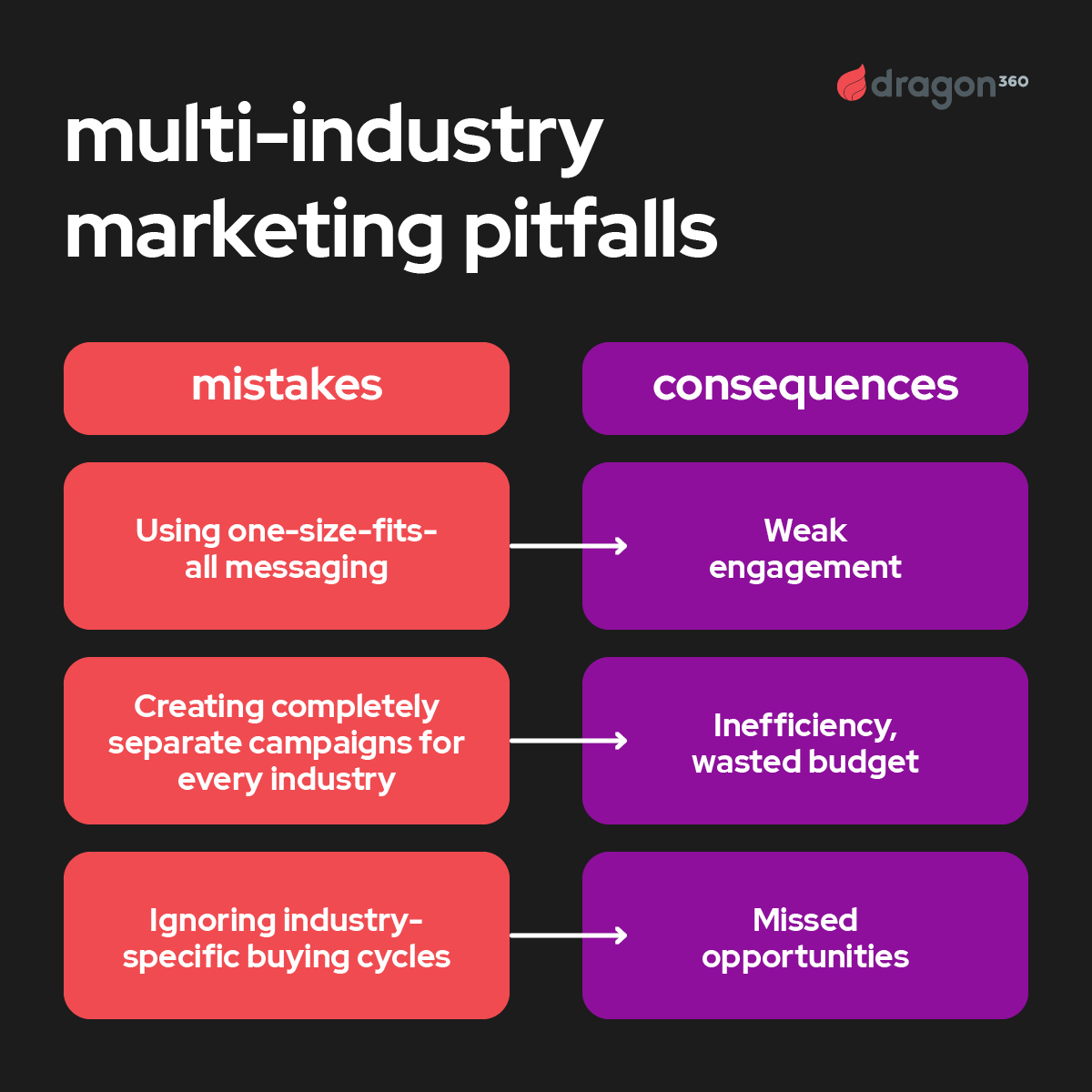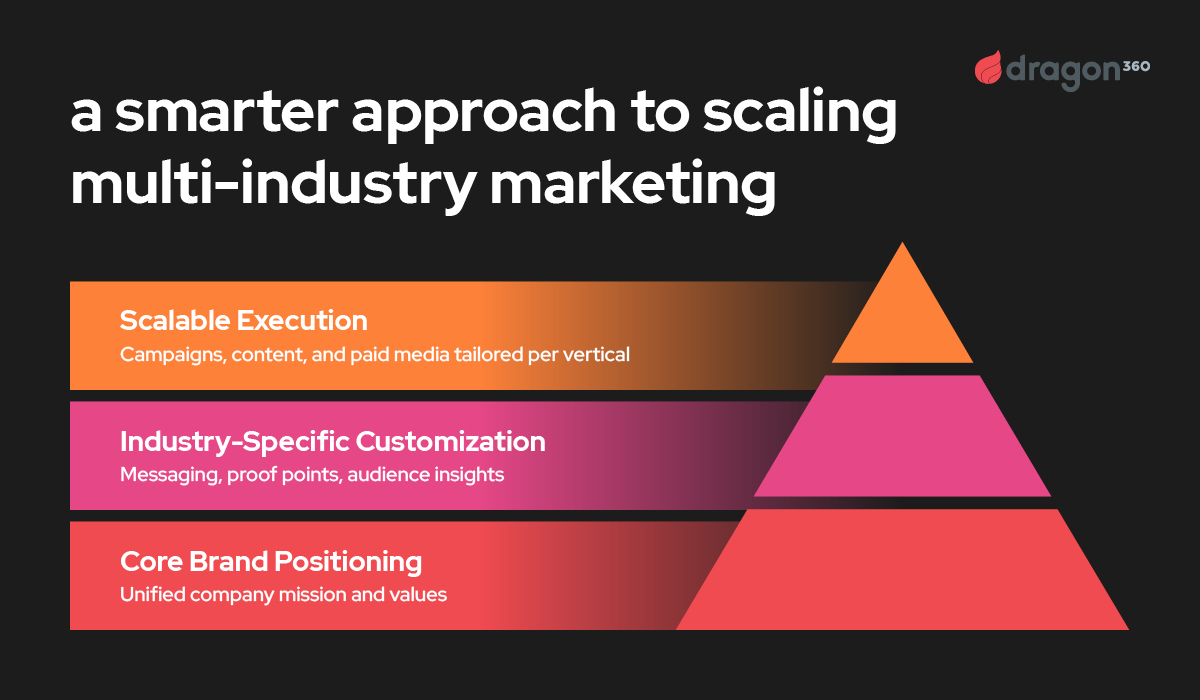Stop Winging It -
Get The Complete B2B Paid Media Guide
Learn how to develop creative that converts and strategy that scales.

Marketing a product that serves multiple industries is no easy feat. Different industries have their own priorities, pain points, and buying behaviors – what clicks with one audience might fall flat with another. And trying to force a one-size-fits-all approach? That’s a fast track to wasting ad spend and losing relevance. At the same time, what resonates in one vertical may completely miss the mark in another, and treating every industry as a completely separate market drains resources and creates operational inefficiencies.
So how do you scale marketing for a product that serves multiple industries without diluting messaging or wasting resources? It starts with finding the right balance between customization and efficiency – understanding where to adapt messaging and campaigns for specific industries while still keeping strategies scalable.
Scaling a product across multiple industries isn’t just about maintaining brand consistency, it’s about actually driving revenue in different markets. Too many companies assume entering a new vertical is as simple as tweaking headlines and swapping out industry logos. But real success requires more than just recognizing surface-level differences. Without a solid foundation that truly understands how each industry thinks, buys, and evaluates solutions, even the best marketing efforts won’t get you far.
Many businesses get multi-industry marketing wrong because they treat it like a copy-paste expansion. They assume what worked in one market will work elsewhere with a few minor tweaks. Every industry has its own dynamics, rules, customer expectations, buying behaviors, and competitive noise. If you don’t adjust accordingly with a tailored approach, instead of a one-size-fits-all strategy, you’re setting yourself up to fail. Without careful adaptation, businesses risk inefficiencies, wasted ad spend, and messaging that fails to resonate.
Here are some of the most common traps to avoid:

One of the biggest mistakes is assuming marketing strategies that worked in one industry will translate seamlessly to another. Industry-specific buyer behavior, sales cycles, and decision-making processes vary widely.
For example:
If you treat all industries the same, your messaging and campaigns will fail to connect, leading to wasted ad spend and weak engagement.
Trying to make marketing campaigns relevant to everyone often results in messaging that resonates with no one. Overly broad messaging lacks specificity and fails to address industry-specific priorities.
Examples of ineffective, overly generic messaging:
Beyond missing the mark, generic messaging creates trust issues. Buyers expect marketing that acknowledges their unique challenges – if they see messaging that feels too broad, they assume the product isn’t really built for them. When messaging lacks specificity, it raises red flags about whether the company truly understands its audience. If a brand claims to serve “every business,” buyers may question whether it actually delivers meaningful solutions for their industry. Instead, messaging should reflect deep customer insights, using language, proof points, and examples that align with the real-world concerns of each target market.
Many companies attempt to solve the multi-industry challenge by creating separate marketing materials for each vertical. While some customization is necessary, unnecessary duplication wastes time, budget, and resources.
A better approach is to develop flexible content that can be adapted across industries without reinventing the wheel:
Each industry has unique buying cycles, decision-makers, and purchase drivers. What works in SaaS won’t work in manufacturing, and what resonates in finance may not matter in healthcare. A common mistake is assuming that pain points are universal, rather than researching what actually influences buying decisions in each sector.
A better way to do this? Stop assuming and start listening. The best insights come from your actual customers and stakeholders – what they care about, how they evaluate options, and what ultimately drives them to buy.
By aligning messaging to industry-specific priorities, brands can create campaigns that resonate more deeply, leading to higher engagement and conversions.
To effectively market across industries, businesses must focus on scalability without losing relevance. This means avoiding the trap of either over-customizing efforts for each vertical – resulting in inefficiency and resource drain – or under-customizing, leading to weak engagement and disconnected messaging. Instead, companies need a structured, repeatable approach that allows them to balance industry-specific needs with overarching brand consistency.
The key is to build an adaptable strategy that leverages deep customer insights, flexible content structures, and data-driven decision-making. Done right, this approach enables businesses to scale effectively across industries without compromising impact.
Here’s how:

Success starts with understanding the nuances of each audience before developing messaging or campaigns. Without this foundation, brands risk making assumptions that don’t align with buyer needs.
With these insights, marketers can map messaging, content, and offers to actual industry needs.
Before creating new content, assess what already exists:
A well-executed industry-specific content audit goes beyond a simple review of existing materials. It requires a structured evaluation of how content aligns with unique market needs, uncovering opportunities to tailor messaging, proof points, and engagement strategies.
This process starts by categorizing content assets based on their flexibility for adaptation across industries. Certain core assets, such as educational whitepapers or product overview decks, can often be adjusted with minimal effort, while other content, like industry case studies or ROI calculators, may require deeper customization.
Key considerations include:
By taking a structured, strategic approach to content auditing, businesses can maximize the impact of existing materials while efficiently adapting them for different industries. This prevents wasted resources and ensures each vertical receives highly relevant, targeted messaging without requiring a complete content overhaul.
Maintaining a unified brand voice across multiple industries is crucial for credibility and recognition. However, a one-size-fits-all approach dilutes impact, making industry-specific messaging essential. To strike the right balance, brands need to ensure their core positioning remains consistent while adapting the framing to match the priorities, challenges, and expectations of each sector.
For example, while a cybersecurity company’s overarching message may focus on “securing digital environments,” the way that message is delivered should differ based on audience needs:
Adapting messaging to these nuanced concerns ensures relevance without fragmenting the brand’s identity. The key is to balance industry-specific storytelling with a strong, overarching brand narrative that remains recognizable and trustworthy.
Scaling across industries doesn’t mean starting from scratch every time. It’s about building a framework that lets you adapt quickly and efficiently without losing impact. If you treat every vertical like an entirely separate world, you’ll burn through resources. If you ignore industry differences, you’ll miss the mark entirely – it’s about modular strategies that flex across verticals while maintaining a core foundation. Businesses often assume that each industry requires an entirely different approach, but the reality is that the most effective multi-industry marketing strategies strike a balance between consistency and customization.
To do this successfully, brands need to identify the core value propositions that resonate across all industries and develop a flexible framework that allows for industry-specific customization. Instead of reinventing messaging, content, and campaigns from scratch for each vertical, companies should leverage structured, repeatable frameworks that allow for quick adjustments while preserving overarching themes.

This ensures marketing efforts remain scalable and efficient, enabling brands to engage multiple industries without draining resources. However, success doesn’t come from simply applying surface-level tweaks to messaging. It requires putting in the time and effort to truly understand the nuances of each audience segment and deliberately crafting a strategy that takes those key, valuable insights into account – making them core at everything you do when going to market. The key lies in structured adaptability – ensuring core messaging remains intact while layering in industry-specific details that resonate with each unique audience.
Marketing across industries isn’t about checking boxes and hoping something sticks. It’s about figuring out what actually drives decisions in each space, and using that intel to build smarter, more effective campaigns. The companies that win aren’t the ones blasting the same message everywhere. They’re the ones taking the time to understand their buyers, adapt their approach, and execute with precision.
This isn’t about making marketing harder – it’s about making it work. Get your customer intelligence dialed in, build adaptable content, and stay sharp about how different industries think. That’s how you drive real growth without wasting time, budget, or effort. It’s about understanding what actually drives action in different markets – then building a playbook that lets you scale without losing impact. The most effective multi-industry marketers don’t just rely on generic segmentation. Instead, they make customer intelligence the foundation of everything they do.
It’s not about chasing broad appeal. It’s about deliberately crafting a strategy that accounts for industry-specific challenges, motivations, and decision-making processes. That means putting in the effort to conduct stakeholder interviews, audience research, and competitive analysis – and using those insights to drive tailored marketing strategies that create meaningful impact.
The key is to strike the right balance: maintaining a cohesive brand presence while ensuring messaging, content, and campaigns speak directly to the unique needs of each industry. This isn’t a one-time effort – it’s an ongoing process of refining, adapting, and optimizing based on real customer insights and performance data.
Successfully marketing a product across multiple industries requires the right balance of consistency and customization. Check out the case study to see how we help Bentley Systems generate demand and connect with industry-specific buyers through a tailored, multi-channel strategy.